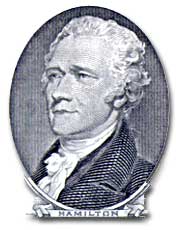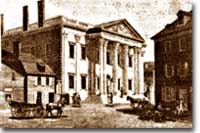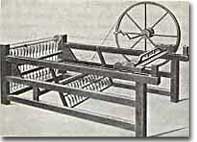


Alexander Hamilton is one of the few American figures featured on U.S. Currency who was never president. He was killed in 1804 in a duel with Aaron Burr.
Presidents Washington ($1), Lincoln ($5), Jackson ($20), and Grant ($50) all appear on currency. But what about this guy Alexander Hamilton on the ten-spot? How did he get there? A sawbuck says you'll know the answer after reading this piece.
A major problem facing the first federal government was how to deal with the financial chaos created by the American Revolution. States had huge war debts. There was runaway inflation. Almost all areas of the economy looked dismal throughout the 1780s. Economic hard times were a major factor creating the sense of crisis that produced the stronger central government under the new Constitution.
George Washington chose the talented Alexander Hamilton , who had served with him throughout the Revolutionary War, to take on the challenge of directing federal economic policy as the treasury secretary. Hamilton is a fascinating character whose ambition fueled tremendous success as a self-made man. Born in the West Indies to a single mother who was a shopkeeper, he learned his first economic principles from her and went on to apprentice for a large mercantile firm. From these modest origins, Hamilton would become the foremost advocate for a modern capitalist economy in the early national United States.
Hamilton's influential connections were not just with Washington, but included a network of leading New York merchants and financiers. His 1780 marriage to Elizabeth Schuyler , from a wealthy Hudson River valley land holding family, deepened his ties to rich and powerful leaders in New York. His innovative financial policies helped overcome the fiscal problems of the Confederacy , and also benefited an economic elite with which he had close ties.

Alexander Hamilton conceived of the First Bank of the United States as a way to standardize American currency and cope with national Revolutionary War debt. The Bank still stands today on Independence National Park in Philadelphia.
The first issue that Hamilton tackled as Washington's secretary of the treasury concerned the problem of public credit . Governments at all levels had taken on so much debt during the Revolution. The commitment to pay them back was not taken very seriously. By the late 1780s, the value of such public securities had plunged to a small fraction of their face value. In other words, state IOU's — the money borrowed to finance the Revolution — were viewed as nearly worthless.
Hamilton issued a bold proposal. The federal government should pay off all Confederation (state) debts at full value. Such action would dramatically enhance the legitimacy of the new central government. To raise money to pay off the debts, Hamilton would issue new securities bonds). Investors who had purchased these public securities could make enormous profits when the time came for the United States to pay off these new debts.

The spinning jenny was one of several major technological innovations that made British textiles such an economic force.
Hamilton's vision for reshaping the American economy included a federal charter for a national financial institution. He proposed a Bank of the United States . Modeled along the lines of the Bank of England, a central bank would help make the new nation's economy dynamic through a more stable paper currency .

The central bank faced significant opposition. Many feared it would fall under the influence of wealthy, urban northeasterners and speculators from overseas. In the end, with the support of George Washington, the bank was chartered with its first headquarters in Philadelphia.
The third major area of Hamilton's economic plan aimed to make American manufacturers self-sufficient. The American economy had traditionally rested upon large-scale agricultural exports to pay for the import of British manufactured goods . Hamilton rightly thought that this dependence on expensive foreign goods kept the American economy at a limited level, especially when compared to the rapid growth of early industrialization in Great Britain.
Rather than accept this condition, Hamilton wanted the United States to adopt a mercantilist economic policy. This would protect American manufacturers through direct government subsidies (handouts to business) and tariffs (taxes on imported goods). This protectionist policy would help fledgling American producers to compete with inexpensive European imports.
Hamilton possessed a remarkably acute economic vision. His aggressive support for manufacturing, banks, and strong public credit all became central aspects of the modern capitalist economy that would develop in the United States in the century after his death. Nevertheless, his policies were deeply controversial in their day.
Many Americans neither like Hamilton's elitist attitude nor his commitment to a British model of economic development. His pro-British foreign policy was potentially explosive in the wake of the Revolution. Hamilton favored an even stronger central government than the Constitution had created and often linked democratic impulses with potential anarchy. Finally, because the beneficiaries of his innovative economic policies were concentrated in the northeast, they threatened to stimulate divisive geographic differences in the new nation.
Regardless, Hamilton's economic philosophies became touchstones of the modern American capitalist economy.
Bet you $10 you now see why he's on the $10 bill.
Founding Fathers: Alexander Hamilton
A solid biography of Alexander Hamilton, from the folks at the National Archives and Records Administration. Brief and nicely written, this page spends as much time on Hamilton's life as a young man as it does on his professional life.
The Duel
This page is part of a larger companion site to a PBS documentary based on the duel with Aaron Burr that ended Alexander Hamilton's life. It gives a good recap of Hamilton's biographical vitals, but its real strength is the detail with which it recounts the scandal that led to the duel.